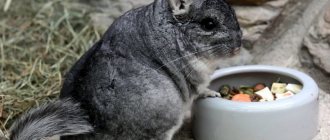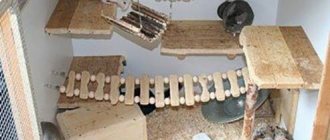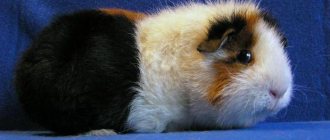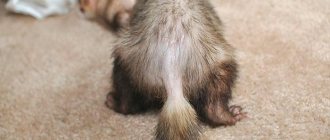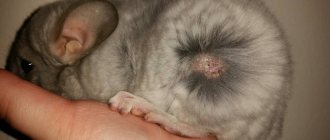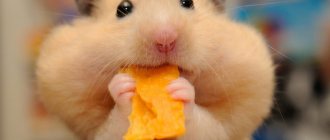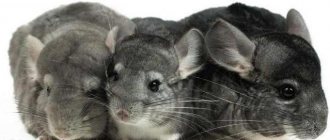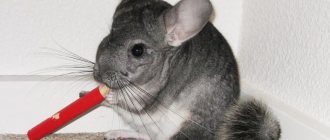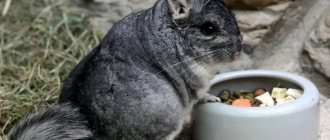Chinchillas A chinchilla is a rodent from the chinchilla family, externally similar to something in between... known both as pets and as fur-bearing animals. Funny appearanceA species is an evolutionarily developed set of individuals, characterized by a single... and cheerful disposition make these animals real pets. But since the chinchilla is a rodent from the chinchilla family, which looks like something in between... and comes from the distant South American Andes, not everyone knows what conditions need to be created for keeping these animals at home.
Domestic chinchilla
Chinchilla A chinchilla is a rodent from the chinchilla family that looks like a cross between a m... is a rodent from the chinchilla family that looks like a cross between a rabbit and a giant mouse with a dash of squirrel in it. The homeland of chinchillas is the southwest of South America, where there are quite a few of these animals left in the wild. There are two species of these animals - chinchilla. Chinchilla is a rodent from the chinchilla family, externally similar to something between m... short-tailed lowland and long-tailed mountain. It is the latter that people raise as fur animals and pets.
On average, ChinchillasA chinchilla is a rodent from the chinchilla family, outwardly similar to something average m... they grow up to 20-35 cm in length (excluding the tail), with females being larger than males. The animals have very thick and pleasant-to-touch fur. The animals have rather large locator ears and whiskers. Both help the chinchilla. The chinchilla is a rodent from the chinchilla family, which looks like something in between... to navigate in pitch darkness. Since these animals come from mountainous areas, they are excellent at climbing any vertical surface that they can cling to, as evidenced by numerous amateur videos of chinchillas.
As pets ChinchillasChinchillas are rodents from the chinchilla family that look like something in between...they are valued for their cute and slightly amusing appearance. In addition, they have a very gentle disposition. While cats, dogs, ferrets and minks, being natural predators, sometimes behave quite aggressively, chinchillaChinchilla is a rodent from the chinchilla family, outwardly similar to something in between m... - the animal, on the contrary, is very peaceful and non-conflict. She almost never bites or scratches unless provoked. The animal that you raised from the cradle will be absolutely tame and completely devoted, like a puppy. In addition, ChinchillasChinchilla is a rodent from the chinchilla family, outwardly similar to something between m... smart enough, they can be taught to independently return to the cage on command after walking around the room.
Under the right conditions for keeping Chinchillas, a Chinchilla is a rodent from the chinchilla family, outwardly similar to something in between m... quite unpretentious. In nature, they live in flocks or colonies, so they get used to the company of people quite easily.
At home ChinchillasChinchillas are a rodent from the chinchilla family, outwardly similar to something in between...they live a little longer than cats and dogs - up to 20 years. Some individuals live up to 25 years or more.
Silence is the key to health
Although these small animals are very noisy, they cannot tolerate loud outside sounds. Therefore, do not place the cage near the TV and try not to frighten the animal with screams and knocks. Such stress can lead an animal to heart failure. Therefore, when experts are asked: “How long does a chinchilla live?” - they can only throw up their hands and say that her life is in your hands. Protect the animal from shocks, and it will delight you with its presence in the house for many years.
Drafts are also unacceptable for their fragile organism. The temperature in the house should not be lower than 21 degrees. Otherwise, the pet may fall ill from hypothermia. Then long and expensive treatment will be required. These are such amazing animals, their fur is considered the warmest. After all, there are more than a thousand “fluffs” in one bulb. Owners of these small rodents will never be able to wear a fur coat from their counterparts. After all, once you look into the eyes of this animal, you will fall in love with it!
Be sure to make yourself such a beautiful and loyal friend. It is better to go for an animal to experienced breeders. They will explain the details of keeping the animal, and you will receive only positive things from communicating with it. Now you know how long a chinchilla lives. And by following all the rules of care and maintenance, you will live side by side with your pet for half its life.
Conditions for chinchilla
Keeping a chinchilla at home is quite simple, but you still need to follow certain rules.
Even if you prefer the animal to roam freely around the apartment while you are at home, it is still better to lock it in a cage during your absence. It should be quite spacious - at least 50x50x60 cm. Preference should be given to cages with metal rods, but in no case with laminated ones. The distance between them should not exceed 1.5 cm. In this case, the cage must have a deep tray with a grate above it, or the cage itself must be placed on such a tray.
Inside the chinchilla cage you need to install several shelves 10-15 cm wide. Moreover, they should be at different heights. Also in the cage you should put a “house”, an automatic drinker and a feeder. It is important that all this is securely fastened, otherwise the chinchilla is a rodent from the chinchilla family that looks like something in between... it will be fun to rattle around these objects all night long.
Chinchilla drinks a lot of water
This is at the same time suspicious, but some problems and illnesses are not always hidden behind this. This is usually due to the hot season or changes in temperature in your room.
Reasons why a lot of people drink a lot of water:
- High temperature in the room, usually drinking plenty of fluids starts at +23
- The cage is placed in direct sunlight
- Air humidity has changed dramatically
- The female is pregnant and it is normal for her to consume a lot of water.
- The animal is sick, but then there must be other symptoms and she will become lethargic.
Domestic chinchilla - care and maintenance
You should adopt a chinchilla at two months of age, since at this time the animal can already feed on its own, but is still able to easily adapt to new conditions and owners. You can determine which chinchilla is healthy. Chinchilla is a rodent from the chinchilla family, which looks like something in between the proposed ones and is healthy by its clean eyes, clean, uniform fur and cheerful appearance. At the same time, it is always better to give preference to professional breeders rather than amateurs.
No matter how cute this animal may seem, like all other phytophages (those that feed on plant foods), chinchillas have an unpleasant feature - they have poor control over the process of defecation. Although, according to reviews of the chinchilla, the chinchilla is a rodent from the chinchilla family, which looks like something in between... and is capable of learning to use a tray, many individuals are completely incapable of mastering this science. Despite the fact that their poop is dry and practically odorless, collecting it all over the house is below average pleasure. This is one of the reasons why most owners prefer to keep chinchillas in cages, only letting them out for a short walk under supervision.
The tray under the cage is filled with either sawdust or granular cat litter. Since the urine and feces of chinchillas practically do not stink, you can change the litter once a week or even less often, which greatly simplifies the maintenance of a chinchilla. A chinchilla is a rodent from the chinchilla family, which looks like something average m... at home.
Chinchillas should absolutely not be bathed in water. Under natural conditions, the animal “washes” in the sand. In an apartment, a special mixture of zeolite dust and sand should be used for these purposes. By the way, it is the purchase of this mixture that will become the main expense item when keeping an animal at home. Any other special care for the Chinchilla's fur coat is not required. The animal itself is very clean, and its fur, for natural reasons, never harbors parasites.
Most owners prefer to keep chinchillas exclusively in a cage, only occasionally taking the animals in their arms or allowing them to walk around the room strictly under supervision. Is it possible for chinchillas to walk on their own? This is a rhetorical question. Left to their own devices, animals can do mischief - chew wires and furniture, destroy pots of indoor plants, etc.
What kind of water to give
It is recommended to give your chinchilla clean filtered or bottled water. You should not use boiled water, which has been subjected to harsh cleaning and contains insufficient amounts of useful microelements.
Apart from plain water, the rodent should not be given any liquid (juice, tea or other drinks). A healthy animal needs only clean water, the temperature of which is between 15-18°C.
During illness, on the recommendation of a specialist, medications are added to the water bowl. They must be given strictly according to the instructions.
When treating diarrhea, chinchillas are given a decoction of oak leaves or herbs, or water with added sugar. For severe symptoms, 1 tsp is enough. If you exceed the dose, the animal will have a reverse reaction in the form of constipation.
What do chinchillas eat?
In the wild, ChinchillasChinchillas are rodents from the chinchilla family, outwardly similar to something in between...they feed on herbaceous plants, primarily cereals and legumes, as well as shrubs and bark. They also sometimes eat insects.
When keeping at home, there is one main rule regarding what Chinchillas eat. A chinchilla is a rodent from the chinchilla family, outwardly similar to something in between m..., or rather, they do not eat: these animals cannot be fed from the table, like a cat or a dog. In addition to the fact that it is not a predator or an omnivore, the chinchilla is a rodent from the chinchilla family, which looks like something in between... it also has a very sensitive digestive system that simply cannot cope with the wrong foods.
For those who have decided to get a chinchilla for the first time, at first you should limit yourself to ready-made concentrated food from a pet store and the recommendations given by the seller of Chinchillas. Chinchillas are a rodent from the chinchilla family, which looks like something in between... In general, all acceptable food can be divided into three types:
- ready-made food for chinchillas;
- cereals;
- greens and dried fruits and vegetables.
When you take a chinchilla into your home, you should buy several types of ready-made food to decide which one your pet will like best. This is important because ready-made food should in any case form the basis of the diet of indoor chinchillas. They are the most nutritious and easily absorbed by the animal’s body.
Purchased food already contains the necessary species. A species is an evolutionarily established set of individuals characterized by a single ... grain, but if desired, chinchillas can be given separate grains of wheat, barley, millet and corn. Also, to the question of what to feed a chinchilla, it is worth adding that the animals willingly eat beans, lentils and peas. As “goodies”, you can pamper your pet with dried fruits and dried vegetables (carrots, raisins, dried apricots, apples). But everything should be dried and in small quantities.
Along with ready-made food, high-quality hay should always be present in the animals’ diet. Without it, the animal will get sick and may die. It is also recommended to buy hay ready-made at a pet store. At least for the first time, until you get the hang of what exactly you need to give your chinchilla. A chinchilla is a rodent from the chinchilla family that looks like something in between...
Also, there should be a dry branch of a tree or bush in the cage at all times. This is not food, it's about chinchilla wood. A chinchilla is a rodent from the chinchilla family, outwardly similar to something in between... a domesticated one will grind down its teeth, which grow without stopping.
You should feed your pet once a day, preferably in the evening. The water in the cage should always be fresh.
How to accustom to a drinking bowl
Chinchillas are smart animals. You can get them used to drinking water fairly quickly. First, the rodent needs to be shown how the new device works.
- Bring the rodent to the drinking bowl.
- Press the lever to let the water flow.
- Give the chinchilla the opportunity to try to get water on his own.
- In some cases, the learning process must be repeated several times.
The drinking bowl is as important a component as the feeder and toys. If your pet stops drinking, it is necessary to identify the reason and act depending on the situation.
Video about which drinking bowl to choose and how each design works. What kind of water can be given to chinchillas, in what quantity and how often to change it.
Chinchillas with other animals
Since the chinchilla is kept in a cage most of the time and is allowed out for walks only under the supervision of its owners, there is no particular problem with coexistence with other pets. However, we can note that the best thing is the chinchilla. The chinchilla is a rodent from the chinchilla family, which looks like something in between m... at home, it gets along with other animals of the rodent order, for example, with hamsters, rabbits, guinea pigs, etc.
Chinchillas usually maintain a reserved neutrality with cats, although conflicts are possible. Especially at first, while the animals get used to each other.
With dogs (non-aggressive breeds) ChinchillasChinchilla is a rodent from the chinchilla family, outwardly similar to something in between m... usually they are friends, but, as in the case of cats, while a chinchillaChinchilla is a rodent from the chinchilla family, outwardly similar to something in between m... small , caution should be exercised.
What do pets get sick of?
Most often, in captivity, chinchillas suffer from dental problems (overgrown hooks) and disorders of the gastrointestinal tract (inflammatory processes in the intestines, diarrhea, food obstruction).
But even an inexperienced person can recognize such diseases. And if the owner takes the necessary measures in time, the rodent’s health will quickly recover.
No vaccinations are provided for rodents living in human homes. They still receive preventive vaccination against dermatitis in the nursery. Proper care and feeding is the key to a painless existence for your pet.
How long do chinchillas live?
Many people are very surprised when they find out that domestic chinchillas. Chinchillas are a rodent from the chinchilla family that looks like something in between. They live longer than cats and dogs. It is believed that in the wild, a chinchilla is a rodent from the chinchilla family, outwardly similar to something average... on average, it lives up to 6-7 years, with a maximum of 10. But this is under constant threat of hunger, cold, predators and poachers.
If we talk about the maximum life expectancy of chinchillas at home, then the results are completely different. Of course, a lot depends on how well the owner takes care of the animal, and also, in some cases, on the breed of chinchillas. But on average, these animals live up to 15-20 years. Also, a certain percentage reaches the age of 25 years. Some sources claim that some individuals even overcome the 30-year mark.
Why does a chinchilla refuse water?
Situations when a chinchilla refuses water can be very diverse. This is often due to the stress that the rodent experiences when changing the owner, the location of the cage, as well as the occurrence of noise and other stressful conditions in which the pet refuses to drink and eat.
What to do if your chinchilla does not drink water:
- If the animal has not touched the water bowl for more than a day, you can try changing the container and replacing the water with fresh water.
- If your chinchilla is stressed, add a small piece of dried apple instead of water. This approach will help provide the animal’s body with a small amount of moisture. When the rodent calms down, he will remember the drinking bowl again.
- If the animal has previously used a drinking bowl of a different shape, perhaps the animal is accustomed to this particular device. In such a situation, the chinchilla must be accustomed to the new design.
- As a last resort, you can give the rodent a drink from a syringe (without a needle). But for a chinchilla this is a lot of stress. The main indication for such actions is prolonged constipation.
Chinchilla - pros and cons
Despite the fact that interest in keeping chinchillas at home is constantly growing, it is safe to say that they will never really compete with cats and dogs as the most popular pets. Due to their natural characteristics, and also due to the fact that, unlike the mentioned cats and dogs, they have not gone through the millennia-long path of adaptation to life next to humans, ChinchillasChinchilla is a rodent from the chinchilla family, externally similar to something in between... they cannot become a full-fledged “four-legged friend.” But they are quite suitable for the role of a decorative pet.
So, here are a few reasons why you should or, on the contrary, should not:
- ChinchillasChinchilla is a rodent from the chinchilla family, outwardly similar to something average m... they feel great in a human home if basic living conditions are created for them - a suitable size cage for ChinchillaChinchilla is a rodent from the chinchilla family, outwardly similar to something average m..., normal nutrition, etc.
- These animals do not naturally have an unpleasant odor. Even the natural secretions of chinchillas have almost no smell. If there is always enough hay in the cage, then the animal’s fur will produce hay.
- Chinchillas A chinchilla is a rodent from the chinchilla family, outwardly similar to something in between... they have a very kind disposition and, in general, are not inclined to show aggression even towards strangers. Guests can always be offered to hold the chinchilla without the slightest risk and take a photo with it in their arms.
- Chinchillas A chinchilla is a rodent from the chinchilla family, outwardly similar to something in between m... very smart, can follow some commands and respond to its nickname.
- Don't be surprised when you find out how long Chinchillas live. A chinchilla is a rodent from the chinchilla family that looks like something in between... When you get a pet, you don’t have to worry that it will die and thereby break your child’s heart.
- Chinchillas A chinchilla is a rodent from the chinchilla family, outwardly similar to something in between... They combine very beautiful fur with a rather stupid expression on their muzzle, which makes them so charming.
"Against":
- These are nocturnal animals that run around the Chinchilla's cage all night long. The Chinchilla is a rodent from the chinchilla family, outwardly similar to something in between m..., they gnaw something, rustle and generally make quite a lot of noise. In view of this, ChinchillasChinchilla is a rodent from the chinchilla family, outwardly similar to something in between... not suitable for those who have very sensitive sleep and do not have the opportunity to put the cage in another room.
- Chinchillas A chinchilla is a rodent from the chinchilla family, which looks like something in between m... can only swim in sand, which inevitably scatters around the “bathroom”, which is why the apartment has to be cleaned more often than usual.
- Although the chinchilla itself, the chinchilla is a rodent from the chinchilla family, outwardly similar to something average m... its dimensions are relatively small, for comfortable keeping this animal requires a large, spacious cage. You should not have a chinchilla in a one-room apartment, where every square meter of space already counts.
- Chinchillas are pleasant to hold in your arms, but the animals themselves are not always willing to agree to such treatment. As is the case with cats, many individuals prefer to be admired from the outside without touching them with their hands.
- Since these are quite rare animals for our country, caring for a chinchilla. A chinchilla is a rodent from the chinchilla family, which looks like something in between m... at home, it is complicated by the fact that it is sometimes very difficult to find a qualified veterinarian or even just a pet store with the necessary products. This is especially difficult in small provincial cities and towns.
Sweet home
It is better to choose a spacious cage for your pet. It would be good if it had a small house, a closed compartment. Chinchillas love privacy. Individuals are found to be very active, they rush around the cage day and night, sleeping only a few hours a day. But it happens the other way around, the animal is lethargic and constantly dozes. Just like humans, they have character and temperament, so watching them is a pleasure.
With proper animal care, you will not have to worry about how long your pet chinchilla lives. The bottom of the cage should be dry and strewn with sawdust or special filler. Paws should not step on moisture. This animal even bathes in the sand. Water is unacceptable to them. The fluffies drink from special sippy cups that hang on the wall.
What treats does a chinchilla eat?
Animals, like children, love to be pampered a little, so you can give them an occasional treat. As treats, you can use raisins, finely chopped dried apricots, dried apples and much more, but only in small quantities. It is also recommended to give barberry and rose hips, as they have special beneficial properties.. Do not overuse nuts .
If you feed your chinchilla greens, you should definitely follow certain rules - the green leaves of clover and dandelion must be sufficiently wilted before serving. It is not recommended to eat a lot of potatoes and beets, and carrots must be washed first.
The presence of wooden chocks and dry branches in the cage also brings joy to the animal. The rodent likes to grind down its front teeth; it needs dry tree branches. It is better to use branches of ordinary trees rather than coniferous ones, as they contain various resins. In addition, on the market you can find special chalk stones that also serve as a mineral supplement.
Caution : It should be noted that the science of proper nutrition is quite inaccurate, so DO NOT HURRY to apply and experiment on your animals everything you have heard somewhere!!!!
How does childbirth proceed in chinchillas?
Before giving birth (2-3 days before), the females remove the bathing suit with sand from the cage, and the nesting house is turned over with the hole facing up. In this position of the house, the female will not be able to throw out of it the material laid there for insulation (hay or straw is usually placed as bedding). 3-6 days after birth, the nest box is turned with the entrance to the side so that the puppies can freely crawl out of it. In cool weather In weather conditions, it is advisable to heat the nest using an electric heater. Such measures will contribute to the normal course of labor and help maintain the health of the female. Before giving birth, the female chinchilla makes a nest for herself in the nesting house. She begins to crush the bedding with her teeth, puts it in a heap, and begins to pluck out her fluff in the belly and chest area. All down plucked by the female should be left in the nest. It happens that a chinchilla does not build a nest for itself, then the owner needs to make it himself from hay and line it with down. As the birth approaches, the female moves little and often lies on her side. During the prenatal period, the animal reacts with increased anxiety to extraneous noises, sudden movements of an approaching person, and flashes of light. It is better not to disturb a pregnant chinchilla again, as its stressful state can be very dangerous in the future. A disturbed female is quite capable of killing or eating her cubs. In order to protect the female from unnecessary worries, the nest is covered with a dark cloth.
During this period it is necessary to handle it with extreme care and caution. When a chinchilla is pregnant and the time is approaching childbirth, the animal should not be picked up
If it is necessary to better show the animal to a veterinarian, pick it up carefully, supporting the belly with your hand from below. In a cage where a pregnant female lives, the bedding needs to be changed more often. It is ideal if the bedding is good wood filler or dry and fresh finely stemmed hay with low thermal conductivity. This bedding retains heat for a long time, so it is of particular value in the cold season. There should be fresh water in the chinchilla cage at all times. The female gives birth between 5-8 am. After giving birth, she can be given sugar, not in large quantities up to 2 grams. The female feeds the puppies with milk, which appears within 24 hours after birth. When examining, seeing that the puppies are “sitting” hunched over and squeaking loudly, you need to carefully and carefully examine the female herself and make sure that she has no milk - the puppies must be fed “artificially”. For this purpose, milk powder is diluted 1:2, condensed or concentrated milk is diluted in the same proportion. Cow's milk and goat's milk are suitable. For the first three days, puppies are fed eight times a day.
The female may become covered again with a male the very next day after giving birth.
Puppies are separated from the female even at one month of age, provided that they are fed boiled milk. But the chinchilla cage must be well insulated. As a rule, the released young animals are kept in spacious cages, several heads each, females and males are separated. And they can live together for up to five months.
With annual counting and analysis, there are usually 5-10% more boys born than girls.
For further breeding, active, strong, good physique and high-quality hair are left. Preferably from fertile parents.
In general, there are no problems with these animals. The female chinchilla is a very caring and good mother!
